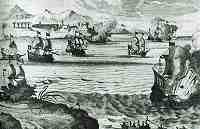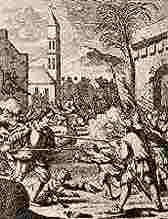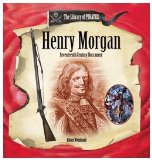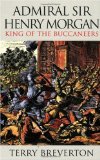More Pirate Pages
Pirate Fun
Henry Morgan, Sir Henry Morgan Pirate

Henry Morgan was born in 1635 to a prosperous Welsh farming family, but he chose life at sea while a young man. After starting as a buccaneer on Tortuga and later in Barbados, he settled around 1660 in Port Royal on Britain's newly acquired island of Jamaica. While an apprentice as captain under Admiral Christopher Myngs, Henry Morgan learned that he could combine service as a British officer with buccaneering operations, and he learned well.
In this article:privateer / Rising Power / Daring Raids / Sir Henry
 After
receiving a commission as privateer in 1662, he realized that he could
avoid having to split any spoils with the government if he attacked on
land, which was not mentioned in his contract. Henry Morgan's fame began
to spread after a two-year journey to Central America begun in 1664 using
land raids on cities like Vilahermosa in Mexico and Gran Granada on Lake
Nicaragua, a waypoint for Spanish silver operations. His uncle Edward
Morgan was appointed lieutenant governor of Jamaica while he was away,
but died in office in early 1665 during an attack on a nearby Dutch island.
After
receiving a commission as privateer in 1662, he realized that he could
avoid having to split any spoils with the government if he attacked on
land, which was not mentioned in his contract. Henry Morgan's fame began
to spread after a two-year journey to Central America begun in 1664 using
land raids on cities like Vilahermosa in Mexico and Gran Granada on Lake
Nicaragua, a waypoint for Spanish silver operations. His uncle Edward
Morgan was appointed lieutenant governor of Jamaica while he was away,
but died in office in early 1665 during an attack on a nearby Dutch island.
Henry married Edward's daughter Mary when he returned the next year, further strengthening his position in Caribbean high society. He was also made Colonel of the militia. While his crew wasted all their rewards on drinking and folly, Morgan began investing in land, plantations, and friendships with political powers like Jamaican governor Thomas Modyford.
By 1668, Henry Morgan was vice-admiral over 15 ships and the elected successor to Edward Mansfield, who headed all piracy based in Jamaica. In that same year, Morgan began a series of large-scale raids in Central America that secured his place as the greatest buccaneer of all:
1) March,1668 Puerto Principe, Cuba -30 miles from Havana :  Morgan
sailed with 10 ships and 500 men as well as Buccaneers from Tortuga.
When the citizens got advance warning of the attack, they laid ambushes
and hid their treasure, which led to their torture when the attackers
arrived. The meager 50,000 pieces of eight that bought their release
was apparently so discouraging that the French companions left Morgan.
His numbers remained strong when another English ship came to participate.
Morgan
sailed with 10 ships and 500 men as well as Buccaneers from Tortuga.
When the citizens got advance warning of the attack, they laid ambushes
and hid their treasure, which led to their torture when the attackers
arrived. The meager 50,000 pieces of eight that bought their release
was apparently so discouraging that the French companions left Morgan.
His numbers remained strong when another English ship came to participate.
2) July, 1668 Porto Bello, Panama : The Spanish shipped their treasure  Buy
Flag (more info) abroad from here and guarded it well
with three forts and many soldiers. Henry Morgan employed a stealth
tactic and arrived on the outskirts by canoe at night. The troops
in the first two forts were quickly overtaken, but the third was
well prepared. After two failed attempts, Morgan ordered priests
and nuns to act as shields while his troops ascended the walls. The
city was quickly taken and then subjected to a month of looting and
torture. It was decided to hold the city for ransom of 350,000 pieces
of eight, to which the governor of Panama responded with troops sent
to retake the city. The troops were ambushed and the governor agreed
to 100,000 pieces of eight, which brought the total loot to 250,000.
Morgan returned to Jamaica, where his forces grew as quickly as his
reputation did.
Buy
Flag (more info) abroad from here and guarded it well
with three forts and many soldiers. Henry Morgan employed a stealth
tactic and arrived on the outskirts by canoe at night. The troops
in the first two forts were quickly overtaken, but the third was
well prepared. After two failed attempts, Morgan ordered priests
and nuns to act as shields while his troops ascended the walls. The
city was quickly taken and then subjected to a month of looting and
torture. It was decided to hold the city for ransom of 350,000 pieces
of eight, to which the governor of Panama responded with troops sent
to retake the city. The troops were ambushed and the governor agreed
to 100,000 pieces of eight, which brought the total loot to 250,000.
Morgan returned to Jamaica, where his forces grew as quickly as his
reputation did.
3) Spring,1669 Maracaibo and Gibraltar on Lake Maracaibo in Venezuela
: When plans to attack Cartagena fell through after a disastrous ship
explosion, Henry Morgan decided to repeat raids that had been executed
by L'Olonnais some eighteen months earlier.  His
eight ships and 650 crew may have exceeded the numbers in the cities,
for most had fled into the jungle with what little they had left: those
who were caught yielded only 10,000 pieces of eight. Upon departure,
Morgan found three Spanish warships at the entrance to the lake. The
admiral scoffed at Morgan's intrepid demand for surrender, but he should
have accepted. Morgan soon destroyed the flagship with explosives sent
aboard a fire ship. One was captured with 20,000 pieces of eight, and
another either escaped or was sunk.
His
eight ships and 650 crew may have exceeded the numbers in the cities,
for most had fled into the jungle with what little they had left: those
who were caught yielded only 10,000 pieces of eight. Upon departure,
Morgan found three Spanish warships at the entrance to the lake. The
admiral scoffed at Morgan's intrepid demand for surrender, but he should
have accepted. Morgan soon destroyed the flagship with explosives sent
aboard a fire ship. One was captured with 20,000 pieces of eight, and
another either escaped or was sunk.
Governor Modyford announced peace with Spain shortly after Morgan's return in May, but by the next year had given permission for answering small Spanish skirmishes with force. Morgan assembled a large force of 2000 buccaneers and over 30 ships.
 4)
1670 Panama : After taking a fort at the mouth of the Chagres river,
Henry Morgan led a two-week trek with 1,400 men through the jungle and
defeated over 1,500 militia and cavalry in a fierce two-hour battle.
The city was then burned either by those fleeing or those attacking,
but regardless, several weeks of picking and the usual torture methods
yielded an estimated 400,000 pieces of eight. Most of the crew was disappointed
that the golden city had yielded so little; the citizens had taken most
of it on a galleon to Ecuador. After the grueling return trip to Chagres,
the loot was divided, and most reports indicate Morgan receiving a much
larger share and abandoning most of his ships and comrades when heading
home to Port Royal.
4)
1670 Panama : After taking a fort at the mouth of the Chagres river,
Henry Morgan led a two-week trek with 1,400 men through the jungle and
defeated over 1,500 militia and cavalry in a fierce two-hour battle.
The city was then burned either by those fleeing or those attacking,
but regardless, several weeks of picking and the usual torture methods
yielded an estimated 400,000 pieces of eight. Most of the crew was disappointed
that the golden city had yielded so little; the citizens had taken most
of it on a galleon to Ecuador. After the grueling return trip to Chagres,
the loot was divided, and most reports indicate Morgan receiving a much
larger share and abandoning most of his ships and comrades when heading
home to Port Royal.
Things did not look great for Henry Morgan in 1671 when he found out his attack on Panama came after peace had been achieved with Spain. Governor Modyford had been sent to prison in London, and the new governor Lynch reluctantly did the same to the national hero in April 1672. Morgan never saw prison and spent his time largely with political leaders. By 1674, he had been knighted and sent back to Jamaica as lieutenant governor to aid the new governor Vaughan in his fight against Holland.
Sir Henry Morgan spent the last years of his life as a fair leader who had his share of political fights and intrigues and enjoyed the favor of the people. He continued to supervise the defenses of the island and to invest in the very lucrative sugar market. His health steadily declined, no doubt aided by his continued heavy drinking, and he died of its effects in 1688. His burial was attended with gun salutes from the forts, ships, and merchants alike.


